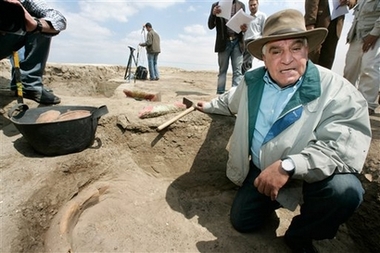Archaeologists unearth remains of fortified city in northern Sinai
 Cairo - Egyptian archaeologists have discovered the remains of the largest ancient fortified city in Sinai while exploring the old Horus military road which once connected Egypt to Palestine, Egypt's antiquities authority said Wednesday.
Cairo - Egyptian archaeologists have discovered the remains of the largest ancient fortified city in Sinai while exploring the old Horus military road which once connected Egypt to Palestine, Egypt's antiquities authority said Wednesday.
The remains of a mud-brick fortress dating from the time of Ramses II (1304-1237 BC) and measuring 500 metres by 250 metres were found in the Sinai peninsula.
The fortress, identified as Tharu fort, has several four-metre- high towers.
Earlier this year archaeologists led by Mohamed Abdel Maksoud found inscriptions that mention three Pharaohs: Tuthmosis II, Seti I and Ramses II.
Abdel Maksoud said that one of the important discoveries is the Horus temple. The temple, which was also built in the time of Ramses II, is the first new Kingdom temple to be discovered in Sinai.
Zahi Hawass, chief of Egypt's Supreme Council of Antiquities (SCA), said that archaeologists have unearthed a relief of King Thutmose II (1516-1504 BC), thought to be the first such royal monument found in Sinai. It indicates that Thutmose II may have built a fort in the area. (dpa)